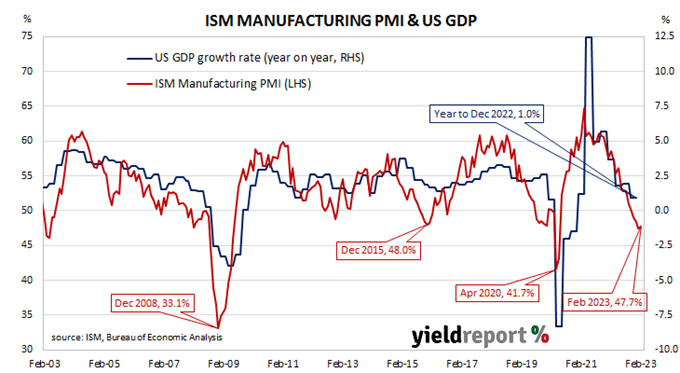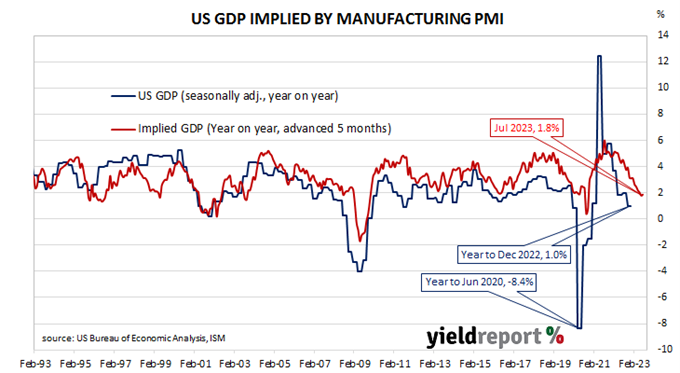Summary: ISM PMI down in March, below expectations; ISM: US manufacturing sector contracts again; US Treasury yields down, expectations of Fed rate rises over next six month firm, softer for 2024; manufacturing among most rate-sensitive sectors; encouraging news on goods inflation; ISM: reading corresponds to 0.9% US GDP contraction annualised.
The Institute of Supply Management (ISM) manufacturing Purchasing Managers Index (PMI) reached a cyclical peak in September 2017. It then started a downtrend which ended in March 2020 with a contraction in US manufacturing which lasted until June 2020. Subsequent month’s readings implied growth had resumed, with the index becoming stronger through to March 2021. Since then, readings have declined steadily.
According to the ISM’s March survey, its PMI recorded a reading of 46.3%, below the generally expected figure of 47.5% as well as February’s 47.7. The average reading since 1948 is 53.0% and any reading below 50% implies a contraction in the US manufacturing sector relative to the previous month.
“The US manufacturing sector contracted again, with the Manufacturing PMI declining compared to the previous month,” said Timothy Fiore, Chair of the ISM’s Manufacturing Business Survey Committee.
US Treasury yields finished the day lower. By the close of business, the 2-year Treasury bond yield had lost 5bps to 3.97%, the 10-year yield had shed 6bps to 3.41% while the 30-year yield finished 1bp lower at 3.64%.
In terms of US Fed policy, expectations of a 25bps rise to the federal funds rate over the next six months firmed slightly while expectations further out softened. At the close of business, contracts implied the effective federal funds rate would average 4.815% in April, 1bp lower than the current spot rate, and then climb to an average of 4.96% in May. June futures contracts implied a 4.965% average effective federal funds rate while April 2024 contracts implied 3.92%.
“A weakening trend has been in place since May last year, but recent banking turmoil may have dented confidence further,” said ANZ senior economist Catherine Birch. “Manufacturing is one of the most rate-sensitive sectors of the economy as goods like autos are primarily bought on credit.”
She also noted lower supplier delivery times and a fall in the prices sub-index, signs she described as “encouraging news on goods inflation.”
Purchasing managers’ indices (PMIs) are economic indicators derived from monthly surveys of executives in private-sector companies. They are diffusion indices, which means a reading of 50% represents no change from the previous period, while a reading under 50% implies respondents reported a deterioration on average. A reading “above 48.7%, over a period of time, generally indicates an expansion of the overall economy” according to the ISM.
The ISM’s manufacturing PMI figures appear to lead US GDP by several months despite a considerable error in any given month. The chart below shows US GDP on a “year on year” basis (and not the BEA annualised basis) against US GDP implied by monthly PMI figures.
According to the ISM and its analysis of past relationships between the PMI and US GDP, March’s PMI corresponds to an annualised contraction rate of 0.9%, or 0.2% over a quarter. Regression analysis on a year-on-year basis suggests a 12-month GDP growth rate of 1.5% five months after this latest report.
The ISM index is one of two monthly US PMIs, the other being an index published by S&P Global. S&P Global produces a “flash” estimate in the last week of each month which comes out about a week before the ISM index is published. The S&P Global flash March manufacturing PMI registered 49.3%, 2.0 percentage points higher than February’s final figure.



